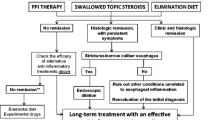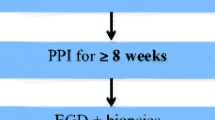Abstract
Background
Symptoms of vomiting and dysphagia in children with eosinophilic esophagitis may be related to the development of mucosal fibrosis.
Aim
Our aims were to (1) investigate esophageal fibrosis in children with EoE compared to patients with gastroesophageal reflux disease and normal individuals, and (2) to assess the degree of mucosal fibrosis in patients with EoE before and after medical treatment.
Methods
A retrospective analysis of esophageal biopsies from patients with EoE, GERD, and normal mucosa was performed. Demographic data, clinical information, eosinophil number, and sub-epithelial fibrosis was compared among the groups. A similar comparison was performed in EoE patients, before and after therapy.
Results
Esophageal biopsies from 53 children were included, of which 17 with EoE, 17 GERD, and 19 were normal. A significantly higher number of eosinophils and greater fibrosis was found in EoE patients vs. GERD and normal (fibrosis grade 2: 13 patients in the EoE group vs. one patient for each control group; p = 0.0001). After therapy, a significant decrease in fibrosis and eosinophils number was noted in EoE patients [fibrosis grade 2: 10 (71.5%) patients vs. one (7.1%) patient, and eosinophil count was 35.5/HPF vs. 13.4/HPF, pre- and post-therapy, respectively; p < 0.05]. The decrease in esophageal fibrosis paralleled the improvement in the related clinical symptoms.
Conclusion
A higher degree of esophageal fibrosis was found in patients with EoE compared to GERD or normal esophagus. Conventional therapy in EoE improved obstructive symptoms, decreased eosinophils count, and reversed the degree of fibrosis. We suggest that appropriate therapy in patients with EoE will improve clinical symptoms and histology.
Similar content being viewed by others
References
Liacouras CA, Bonis P, Putnam PE, et al. Summary of the first International Gastrointestinal Eosinophil Research Symposium. J Pediatr Gastroenterol Nutr. 2007;45:370–391.
Furuta GT, Liacouras CA, Collins MH, et al. Eosinophilic esophagitis in children and adults: a systemic review and consensus recommendations for diagnosis and treatment. The First International Gastrointestinal Eosinophil Research Symposium. Gastroenterology. 2007;133(4):1342–1363.
Lucendo AJ, Pascual-Turrion JM, Navarro M, et al. Endoscopic, bioptic, and manometric findings in eosinophilic esophagitis before and after steroid therapy: a case series. Endoscopy. 2007;39:765–771.
Fox VL, Nurko S, Teitelbaum JE, et al. High-resolution EUS in children with eosinophilic “allergic” esophagitis. Gastrointest Endosc. 2003;57:30–36.
Chehade M, Sampson HA, Morotti RA, et al. Esophageal subepithelial fibrosis in children with eosinophilic esophagitis. J Pediatr Gastroenterol Nutr. 2007;45:319–328.
Aceves SS, Newbury RO, Dohil R, et al. Esophageal remodeling in pediatric eosinophilic esophagitis. J Allergy Clin Immunol. 2007;119:206–212.
Aceves SS, Newbury RO, Chen D, Mueller J, Dohil R, Hoffman H, Bastian JF, Broide DH. Resolution of remodeling in eosinophilic esophagitis correlates with epithelial response to topical corticosteroids. Allergy. 2009. [Epub ahead of print].
The non-neoplastic esophagus. In: Fenoglio-Preiser CM et al., eds. Gastrointestinal pathology: an atlas and text, 3rd edn. Philadelphia: Lippincott-Williams & Wilkin; 2008.
Khan S, Orenstein SR, Di Lorenzo C, et al. Eosinophilic esophagitis: strictures, impactions, dysphagia. Dig Dis Sci. 2003;48:22–29.
Odze RD. Pathology of eosinophilic esophagitis: what the clinician needs to know. Am J Gastroenterol. 2009;104:485–490.
Teitelbaum JE, Fox VL, Twarog FJ, et al. Eosinophilic esophagitis in children: immunopathological analysis and response to fluticasone propionate. Gastroenterology. 2002;122:1216–1225.
Shah A, Hirano I. Treatment of eosinophilic esophagitis: drugs, diet, or dilatation? Curr Gastroenterol Rep. 2007;9:181–188.
Gupta SK, Fitzgerald JF, Kondratyuk T, et al. Cytokine expression in normal and inflamed esophageal mucosa: a study into the pathogenesis of allergic eosinophilic esophagitis. J Pediatr Gastroenterol Nutr. 2006;42:22–26.
Aceves SS, Ackerman S. Relationships between eosinophilic inflammation, tissue remodeling, and fibrosis ineosinophilic esophagitis. Immunol Allergy Clin N Am. 2009;29:197–211.
Maples KM, Henderson SC, Graham M, et al. Treatment of eosinophilic esophagitis with inhaled budesonide in a 7-year-old boy with concomitant persistent asthma: resolution of esophageal submucosal fibrosis and eosinophilic infiltration. Ann Allergy Asthma Immunol. 2007;99:572–574.
Blanchard C, Mingler MK, Vicario M, et al. IL-13 involvement in eosinophilic esophagitis: transcriptome analysis and reversibility in glucocorticoids. J Allergy Clin Immunol. 2007;120:1292–1300.
Pentiuk S, Putnam PE, Collins MH, Rothenberg M. Dissociation between symptoms and histological severity in pediatric eosinophilic esophagitis. J Pediat Gastroentrol Nutr. 2009;48:152–160.
Straumann A, Spichtin HP, Grize L, Bucher KA, Beglinger C, Simon HU. Natural history of primary eosinophilic esophagitis: a follow-up of 30 adult patients for up to 11.5 years. Gastroenterology. 2003;125:1660–1669.
Nago P, Furuta GT, Antonioli DA, Fox VL. Eosinophils in the esophagus: peptic or allergic esophagitis? Case series of three patients with esophageal eosinophilia. Am J Gastroenterol. 2006;101:1666–1670.
Molina-Infante J, Ferrando-Lamana L, Mateos Rodriguez JM, et al. Overlap of reflux and eosinophilic esophagitis in two patients requiring different therapies: a review of the literature. World J Gastroenterol. 2008;14:1463–1466.
Molina-Infante J, Ferrando-Lamana L, Fernandez-Bermejo M, Porcel-Carreno S. Eosinophilic esophagitis in GERD patients: a clinic-pathological diagnosis using proton pump inhibitors. Am J Gastroenterol. 2009;104:2856–2857.
Dubecz A, Mentrikoski M, Peter JH. Eosinophilic esophagitis with severe GERD. Am J Gastorentrol. 2009;104:527–529.
Author information
Authors and Affiliations
Corresponding author
Rights and permissions
About this article
Cite this article
Abu-Sultaneh, S.M.A., Durst, P., Maynard, V. et al. Fluticasone and Food Allergen Elimination Reverse Sub-epithelial Fibrosis in Children with Eosinophilic Esophagitis. Dig Dis Sci 56, 97–102 (2011). https://doi.org/10.1007/s10620-010-1259-5
Received:
Accepted:
Published:
Issue Date:
DOI: https://doi.org/10.1007/s10620-010-1259-5




